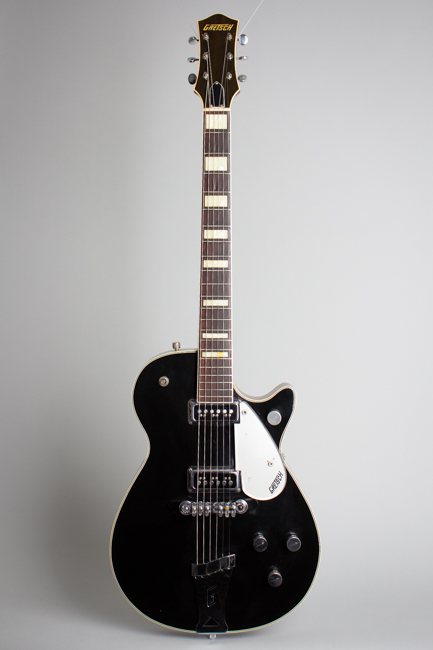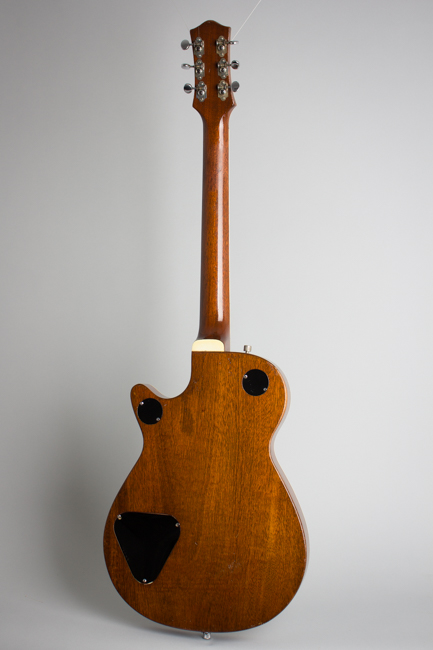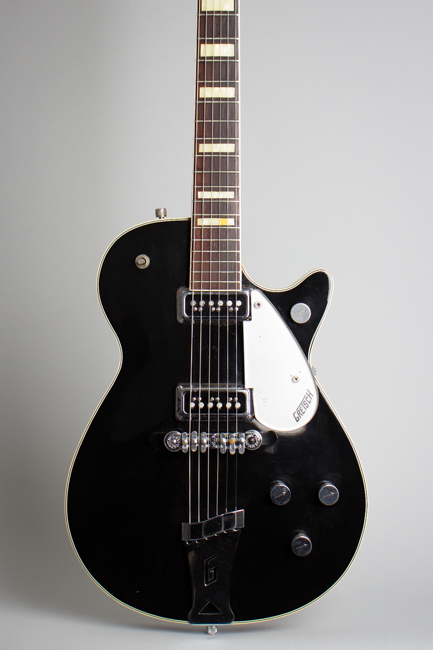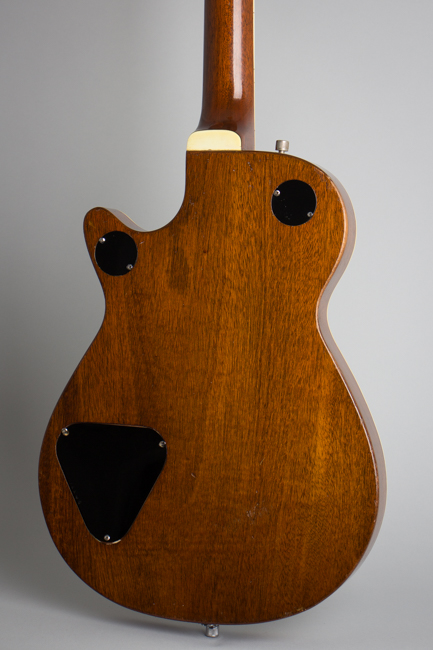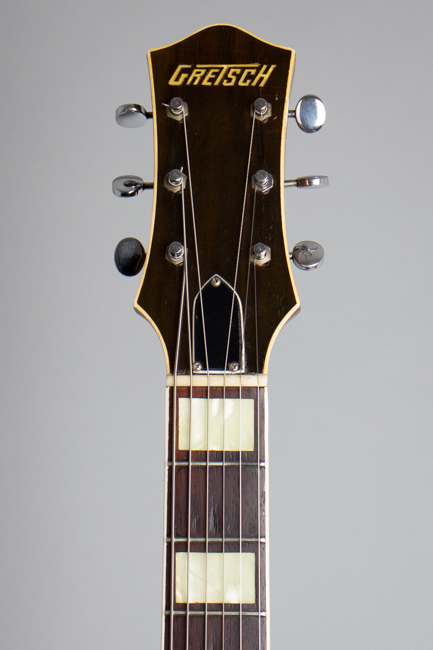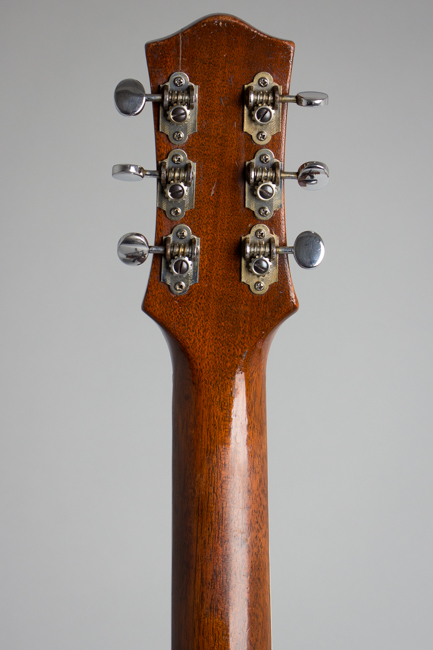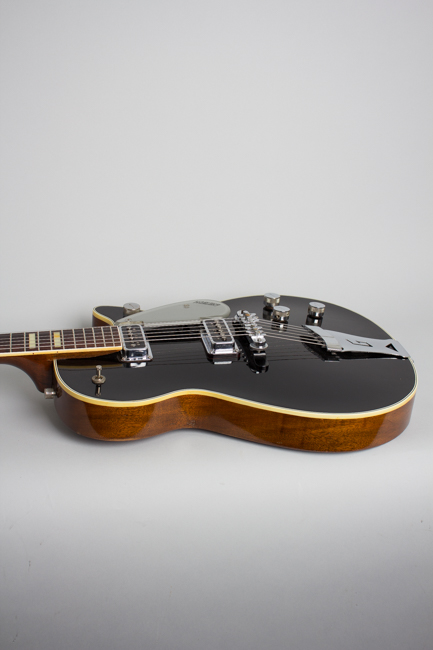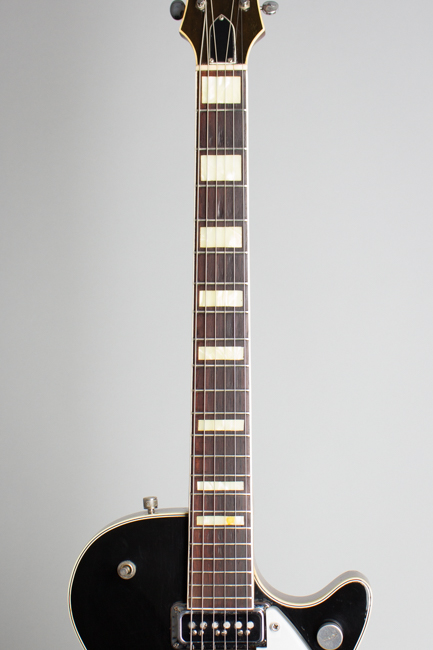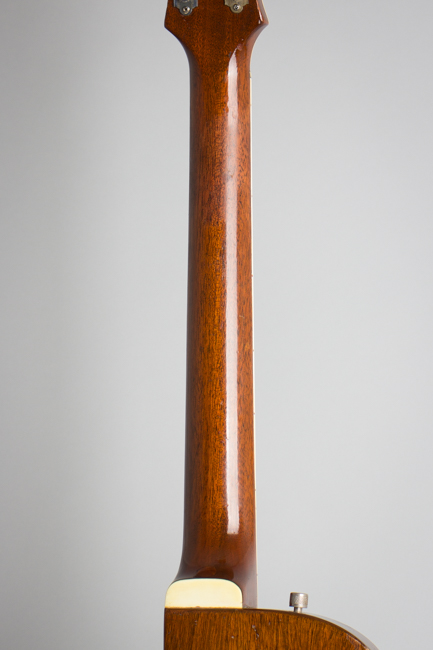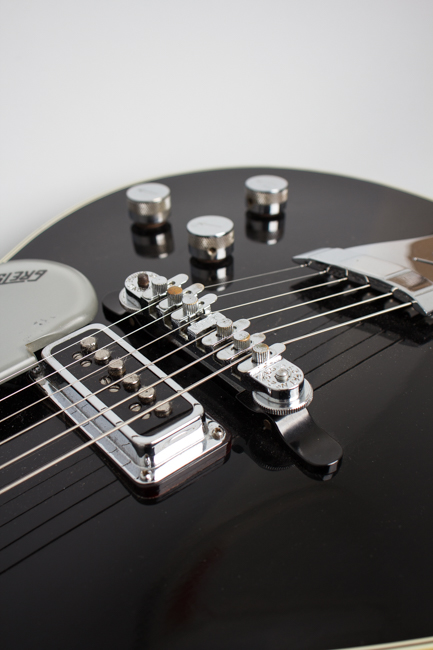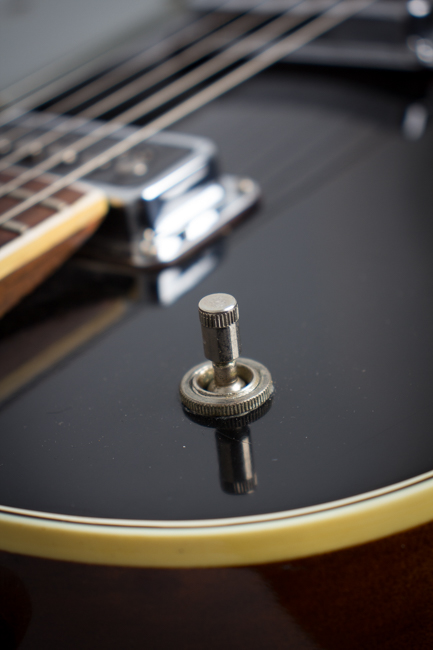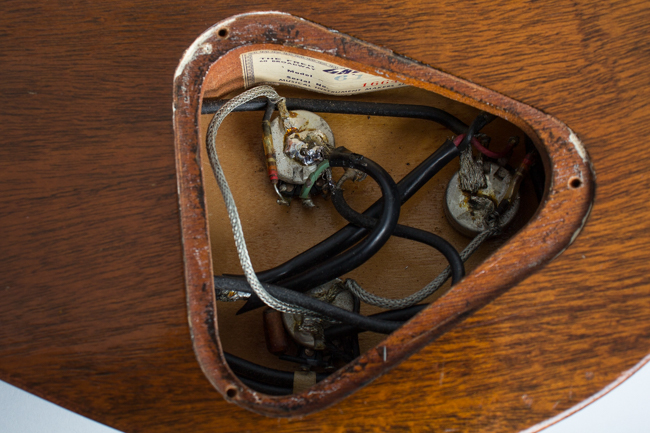Gretsch PX 6128 Duo Jet Solid Body Electric Guitar (1955)
This item has been sold.
Item # 8923
Prices subject to change without notice.
Gretsch PX 6128 Duo Jet Model Solid Body Electric Guitar (1955), made in Brooklyn, NY, serial # 16649, silver sparkle top, natural back and sides finish, mahogany body and neck, rosewood fingerboard, black gig bag case.
This lovely gleaming black Gretsch Duo Jet from early 1955 has the typical features of the period, about two years into the model's run. As Gretsch specifications were pretty much constantly evolving that is the story for most of their instruments! The Gretsch Jet series were introduced on the heels of Gibson's Les Paul in late 1953. The company officially described them as solidbodies but they are actually chambered semi-solids, rather lighter than their Gibson competitors. A plywood top is mounted over the hollowed-out mahogany lower body, with some extra blocking installed but still plenty of open space inside.
This Duo Jet carries a black Nitron plastic-covered top on a natural-finished mahogany body, with a bound, pearloid block inlaid rosewood fingerboard on the mahogany neck. The twin pickups are the DeArmond Dynasonic units that Gretsch had used since the early 1950s; in 1958-9 they would be replaced by the new Filter 'Tron humbuckers. The sound on the DeArmond equipped Jets is brighter and falls in between the typical '50s Gretsch hollowbody and a true solid guitar, with a lot of bite but more airy quality than a Les Paul. Other typical 1955-6 fittings include the early adjustable Melita bridge, a "G" logo trapeze tailpiece, silver back-painted clear Lucite pickguard and the earlier "arrow" chrome knobs. The truss rod cover is the earlier small piece used until 1956. The hardware is chrome plated, giving the guitar a sort of badass '50s automotive look.
The Duo Jet was a fairly popular guitar in the 1950's, one of Gretsch's success stories. The single best regarded user was Cliff Gallup in Gene Vincent's band but a number of early Rock'n'Roll and "Hillbilly" performers made use of this or other Jet variations: the red-and-black Jet Fire Bird and flashy Silver Jet with a Nitron sparkle top. Over the years the Jets have proved to be one of Gretsch's classic designs, and after being somewhat forgotten in the later 1960s and '70s have returned to favor as one of the Brooklyn company's best regarded and most enduringly popular models.
Overall length is 39 3/8 in. (100 cm.), 13 1/2 in. (34.3 cm.) wide at lower bout, and 2 in. (5.1 cm.) in depth, measured at side of rim. Scale length is 24 1/2 in. (622 mm.). Width of nut is 1 3/4 in. (44 mm.).
This is a very nice example of this early-style Jet in largely original and fine playing condition. There has been some minor and very accurate restoration; the neck pickup was rewound by Tom Brantley, who is the best in the business and it sounds great, exactly as it should. The original tortoise plastic pickup risers were the culprit, they tend to suffer celluloid outgassing and can often take the pickup coil with them. The rings on this guitar are exact reproductions, and even most experienced Gretsch fans would be hard-pressed to notice the replacement. Many 1950s Gretsch guitars with DeArmonds are experiencing this problem and we advise owners to examine these often-unnoticed parts regularly for signs of decay!
Overall there is fairly minor wear to the finish on the guitar, with no major areas of loss. The lacquer shows the expected collection of small scratches and dings, with some more noticeable belt buckle scratching on the back. The back of the neck also has some small dings and dents and there is wear down to the wood on the edges and in the lower positions. The plastic top is less affected as one might expect and shows only very light marks, mostly scuffing under the bridge feet. All hardware is original; a few of the screws holding the back plates on are mismatched.
This Duo Jet has no binding distress and the neck angle is excellent -- both often sore points on older Gretsch guitars. The binding around the top and fingerboard shows virtually no shrinking or celluloid deterioration. There is a tight ancient grain split on the back of the headstock through the screws on the G string tuner to upper tip; this is solidly sealed but visible and not a structural issue. The guitar has the neck reset, as is very common on 1950s Gretsch guitars. It is a clean job; at some point a later 1958-9 style heel dowel was added; this may be the sign of factory work in this area fairly early on. The frets are original and appear to have been crowned down just a bit with hardly any subsequent wear; the nut is shimmed up a bit and is either the original re-worked or a later replacement.
This Jet apparently lost its case somewhere along the decades; it resides in a well-fitted pro quality gig bag. It is an excellent player and sounds great, perhaps not as perfect as some Jets we have had but a fine 1950s Gretsch nonetheless. Excellent - Condition.
This lovely gleaming black Gretsch Duo Jet from early 1955 has the typical features of the period, about two years into the model's run. As Gretsch specifications were pretty much constantly evolving that is the story for most of their instruments! The Gretsch Jet series were introduced on the heels of Gibson's Les Paul in late 1953. The company officially described them as solidbodies but they are actually chambered semi-solids, rather lighter than their Gibson competitors. A plywood top is mounted over the hollowed-out mahogany lower body, with some extra blocking installed but still plenty of open space inside.
This Duo Jet carries a black Nitron plastic-covered top on a natural-finished mahogany body, with a bound, pearloid block inlaid rosewood fingerboard on the mahogany neck. The twin pickups are the DeArmond Dynasonic units that Gretsch had used since the early 1950s; in 1958-9 they would be replaced by the new Filter 'Tron humbuckers. The sound on the DeArmond equipped Jets is brighter and falls in between the typical '50s Gretsch hollowbody and a true solid guitar, with a lot of bite but more airy quality than a Les Paul. Other typical 1955-6 fittings include the early adjustable Melita bridge, a "G" logo trapeze tailpiece, silver back-painted clear Lucite pickguard and the earlier "arrow" chrome knobs. The truss rod cover is the earlier small piece used until 1956. The hardware is chrome plated, giving the guitar a sort of badass '50s automotive look.
The Duo Jet was a fairly popular guitar in the 1950's, one of Gretsch's success stories. The single best regarded user was Cliff Gallup in Gene Vincent's band but a number of early Rock'n'Roll and "Hillbilly" performers made use of this or other Jet variations: the red-and-black Jet Fire Bird and flashy Silver Jet with a Nitron sparkle top. Over the years the Jets have proved to be one of Gretsch's classic designs, and after being somewhat forgotten in the later 1960s and '70s have returned to favor as one of the Brooklyn company's best regarded and most enduringly popular models.
Overall length is 39 3/8 in. (100 cm.), 13 1/2 in. (34.3 cm.) wide at lower bout, and 2 in. (5.1 cm.) in depth, measured at side of rim. Scale length is 24 1/2 in. (622 mm.). Width of nut is 1 3/4 in. (44 mm.).
This is a very nice example of this early-style Jet in largely original and fine playing condition. There has been some minor and very accurate restoration; the neck pickup was rewound by Tom Brantley, who is the best in the business and it sounds great, exactly as it should. The original tortoise plastic pickup risers were the culprit, they tend to suffer celluloid outgassing and can often take the pickup coil with them. The rings on this guitar are exact reproductions, and even most experienced Gretsch fans would be hard-pressed to notice the replacement. Many 1950s Gretsch guitars with DeArmonds are experiencing this problem and we advise owners to examine these often-unnoticed parts regularly for signs of decay!
Overall there is fairly minor wear to the finish on the guitar, with no major areas of loss. The lacquer shows the expected collection of small scratches and dings, with some more noticeable belt buckle scratching on the back. The back of the neck also has some small dings and dents and there is wear down to the wood on the edges and in the lower positions. The plastic top is less affected as one might expect and shows only very light marks, mostly scuffing under the bridge feet. All hardware is original; a few of the screws holding the back plates on are mismatched.
This Duo Jet has no binding distress and the neck angle is excellent -- both often sore points on older Gretsch guitars. The binding around the top and fingerboard shows virtually no shrinking or celluloid deterioration. There is a tight ancient grain split on the back of the headstock through the screws on the G string tuner to upper tip; this is solidly sealed but visible and not a structural issue. The guitar has the neck reset, as is very common on 1950s Gretsch guitars. It is a clean job; at some point a later 1958-9 style heel dowel was added; this may be the sign of factory work in this area fairly early on. The frets are original and appear to have been crowned down just a bit with hardly any subsequent wear; the nut is shimmed up a bit and is either the original re-worked or a later replacement.
This Jet apparently lost its case somewhere along the decades; it resides in a well-fitted pro quality gig bag. It is an excellent player and sounds great, perhaps not as perfect as some Jets we have had but a fine 1950s Gretsch nonetheless. Excellent - Condition.
